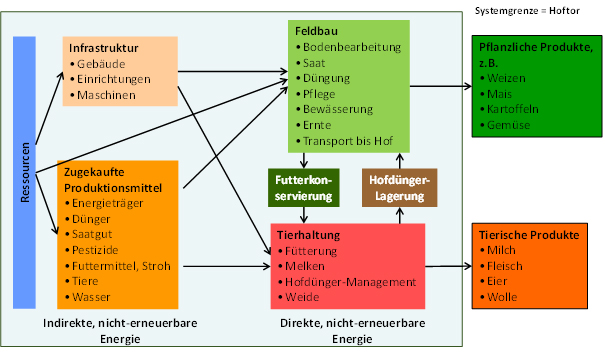Energy Demand and Energy Efficiency
The agri-environmental indicator ‘energy demand’ describes the demand for energy resources used to run a farm. Non-renewable energy resources, i.e. petroleum, natural gas, uranium, hard coal and lignite, account for the lion’s share.
The agri-environmental indicator ‘energy efficiency’ is calculated from the indicator ‘energy demand’ by dividing the energy demand by the digestible energy (for humans) produced by the farm.
The indicator is calculated according to the so-called life-cycle approach, using the SALCA Life-Cycle Assessment Method
Here, in addition to the direct energy demand on the farm, the demand for the production and transport of imported resources (e.g. energy for the production of mineral fertilisers) is also taken into account. The farm gate constitutes the spatial system boundary for the products considered. For plant production, the temporal calculation begins after the harvest of the previous main crop, and ends with the harvest of the current main crop. For other sectors (e.g. permanent crops, bought-in production resources, animal production), the calendar year serves as the reference period. Energy demand is given with reference to the utilised agricultural area of the farm, allowing the comparison of farms of different sizes.
Many resources whose production requires energy are recorded by SAEDN farms
Among these are: mineral fertilisers, plant protection products, seed and purchased animals. The energy demand of these elements was determined using the SALCA and ecoinvent life-cycle inventories.
Assumptions are made for certain resources whose production requires energy
Experience shows that infrastructure, machinery and imported feed concentrates account for a large percentage of a farm’s energy demand. Since these are not recorded within the SAEDN, assumptions had to be made about the size of these factors. The relative share of energy demand of infrastructure and machinery is taken from the national statistics. The quantity and composition of the bought-in feed-concentrate mixtures was taken from Agridea’s Gross-Margin Catalogue for each animal category.
The energy demand for these concentrates was then calculated from life-cycle inventory databases for each animal category. The energy-resource demand for concentrates per animal category was estimated in this way for both PEP (Proof of Ecological Performance) and organic farms. For each animal category, these values are multiplied by the number of animals living on the farm.
Digestible Energy for Humans
To determine energy efficiency, the energy demand is placed in context with the energy produced on the farm which is digestible by humans. If, for example, the energy required to produce one kilogram of potatoes and one kilogram of carrots is the same, the kilogram of potatoes is more energy-efficient, since it supplies more energy to the human diet (i.e. contains more calories).
Feedstuffs are not directly consumed by humans, but rather indirectly in the form of products of animal origin such as milk or meat. When evaluating feedstuffs, therefore, conversion factors were applied in order to express their digestible energy for humans. For this, we used standardised production scenarios. The information regarding the average percentage of a product serving as animal feed or human food comes from Swiss Farmers’ Union statistics. Only products leaving the farm (e.g. sold wheat) are taken into account.







